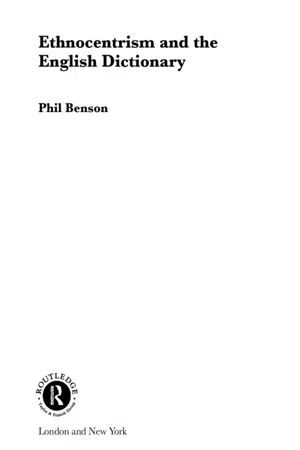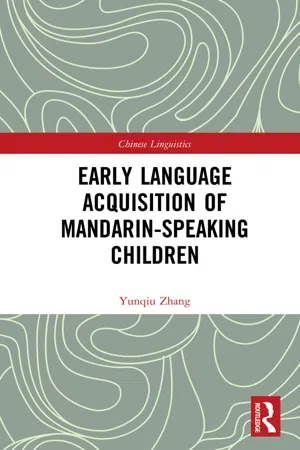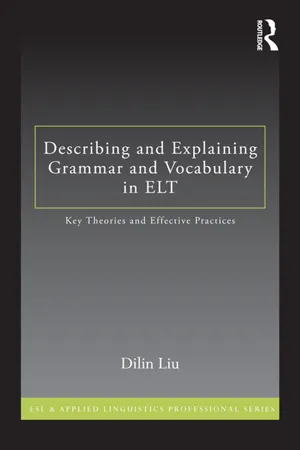Languages & Linguistics
Subjective Description
Subjective description refers to a type of description that is based on personal opinions, feelings, and interpretations. It is often used in creative writing and literature to convey emotions and sensory experiences. In linguistics, subjective description can be used to analyze language use and how it reflects the speaker's attitudes and beliefs.
Written by Perlego with AI-assistance
Related key terms
Related key terms
1 of 4
Related key terms
1 of 3
3 Key excerpts on "Subjective Description"
- eBook - ePub
- Phil Benson(Author)
- 2002(Publication Date)
- Routledge(Publisher)
The point here is not simply that linguists and lexicographers have on occasion used the dictionary as a metaphor for the objectivity of language. It is rather that there seems to be no other way of conceiving of that objectivity other than in terms of its description in some externalised metalinguistic form. It is in the sense that the practice of describing languages is both logically and historically prior to the conceptualisation of languages as objects that can be described, that dictionaries can be understood as representations of languages. The notion of a dictionary as a representation, rather than a description, of a language implies metalinguistic processes of objectification, in which the language is constructed as an object within the field of social knowledge. While the notion of metalinguistic representation does not necessarily deny the objective existence of languages, it does imply the impossibility of separating our knowledge of a language from the metalinguistic form in which that knowledge is represented.The assumption that languages are capable of objective description has been undermined in the late twentieth century, not only by critics of Saussurean linguistics such as Harris, but also by approaches that more generally call into question the idea that words have determinate meanings independently of their contexts of use. More than 50 years ago, Hjelmslev argued:The so-called lexical meanings in certain signs are nothing but artificially isolated contextual meanings, or artificial paraphrases of them. In absolute isolation no sign has any meaning; any sign meaning arises in a context, by which we mean a situational context or explicit context, it matters not which, since in an unlimited or productive text (a living language) we can always transform a situational into an explicit context.(Hjelmslev, 1943/1961: 45)This formulation of the problem of lexical meaning, which has largely informed the development of linguistic pragmatics, undermines the notion that the senses of words are determinate within the linguistic system (Mey, 1993: 139). Although intuition suggests that many words do indeed have determinate meanings independently of their contexts of use, attention has shifted towards the ways in which these meanings are socially constructed and appear and disappear in response to social and ideological change. - Yunqiu Zhang(Author)
- 2019(Publication Date)
- Routledge(Publisher)
In recent years, the subjectivity and subjectivization of language have attracted the attention of Chinese linguists (Shen, 2001a, 2002; Song, 2005; Zhang, 2005; Shi, 2003, 2005; Xing, 2005; L. Zhang, 2007; B. Zhang, 2007; Cui, 2009, etc.). This is due not only to the abundant research done by non-Chinese researchers but also to the prevalence of subjectivity in the language system, such that it is difficult for linguists to circumvent it to explain related linguistic phenomena. The subjectivity of language is so ubiquitous and complex that we cannot help but wonder about its situation in children’s language. Is it innate or learned? What is the distribution of various expressions of subjectivization of adult language in children’s language at different ages? How does the cognitive ability associated with expressions of subjectivization develop? Is the subjectivity of language as the semantic meaning of the interactions between the subjective and the objective related to children’s syntactic development? This being our point of departure, this chapter hopes to explain the acquisition of expressions of subjectivization of young Chinese children by exploring the developmental corpus of a child of Beijing dialect before the age of 04;00. In doing so, we explore issues such as the restrictive factors of subjective development and the relationship between subjectivity and children’s syntactic development.According to Lyons (1977), subjectivity refers to the speaker expressing his or her stance, attitude, and emotion towards the topic of his or her speech while speaking, thus leaving a mark of the self in the discourse. Subjectivization refers to the linguistic adaptation of a corresponding structural form or a corresponding evolutionary process in order to express subjectivity. The concept of subjectivization embodies two levels of meaning: one is synchronic subjectivization, which is the structural form adopted by language in order to express subjectivity; the other is diachronic subjectivization, which is the evolutionary process of language in order to express subjectivity. The expressions of subjectivization in this chapter refer to the concept of synchronic subjectivization. It specifically pertains to the use of particular words or structures in order to express the speaker’s evaluation, attitude, and emotions regarding the topic of the speech.- eBook - ePub
Describing and Explaining Grammar and Vocabulary in ELT
Key Theories and Effective Practices
- Dilin Liu(Author)
- 2013(Publication Date)
- Routledge(Publisher)
However, it is very important to point out that no single linguistic theory alone is adequate for developing effective and useful pedagogical language description, no matter how contemporary and sound the theory is. The reason that we should not try to base our grammar and vocabulary descriptions on one single theory is threefold. First, the purpose of pedagogical language description, as noted earlier, is to help language learners better grasp grammar and vocabulary usages, so, in designing and giving grammar and vocabulary descriptions, there are many factors we need to take into consideration (such as learner age and learning purpose), and some important principles we should follow (such as clarity and simplicity— issues that will be discussed in detail below in Section 1.4). Second, every linguistic theory may have its own particular weakness, especially from a language learning/teaching perspective. A theory can be sound and comprehensive but it may be too complex and/or too abstract in some of its concepts or procedures of analysis. Third, there is no consensus among researchers that any particularly linguistic theory is more advantageous than others when applied in grammar teaching (Hudson, 2001).1.3 The importance of language descriptionThe importance of language description in language learning and teaching is twofold. First, besides factors such as learner needs and the degree of usefulness of language items, language description greatly influences what language structures and usages are taught and how they are taught. This is because language lessons and teaching materials such as textbooks are often based on the language descriptions provided by linguists with a particular theoretical background. For instance, a textbook which used linguistic descriptions based on structural linguistic theories and was published before corpora were widely used would often focus mostly on grammatical units and rules and present them largely in isolation (i.e., without adequate contextual information illustrating them as choices for effective communication) by using many made-up sentences, rather than authentic ones taken or adapted from corpus data. On the other hand, a textbook based on systemic functional linguistic descriptions and published after corpus linguistics became popular tends to (1) focus on language (lexicogrammatical) units as part of a system or systemic resources that people use for communicative functions and (2) present them in meaningful contexts, employing corpus-based materials, e.g., Celce-Murcia & Sokolik’s (2007–2009) Grammar connection 1–5 series
Index pages curate the most relevant extracts from our library of academic textbooks. They’ve been created using an in-house natural language model (NLM), each adding context and meaning to key research topics.
Explore more topic indexes
Explore more topic indexes
1 of 6
Explore more topic indexes
1 of 4


